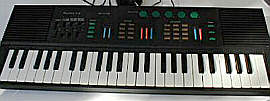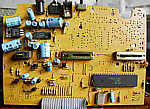
(picture taken from eBay, showing
my specimen)
|

(picture taken from eBay, showing
my specimen)
|
The automatic accompaniment of this instrument plays in fingered chord mode when 2 chord section keys are pressed the same simple pattern like when only 1 key is pressed; as well the HBATEC as the Letron MC-3 play here a duet pattern instead. Unlike the HBATEC, with rhythm off the "fingered" and "single finger" buttons don't enable an organ chord mode despite their LED is lit. Instead of the "manual bass" button there is an "arpeggio" button; the arpeggio pattern is mixed into the main voice and thus can be also played without rhythm and accompaniment by simply setting these volume faders to zero. The arpeggio uses a slightly different (less cheesy) style than the arpeggio easteregg I found on my HBATEC, and its sound also employs here a slow decay envelope. The rhythm tempo can be set even yet another step higher than the already tremendously fast one of the HBATEC, which turns it fully into a rapidly purring drumroll; especially in combination with arpeggio this provides the famous fast arpeggiator patterns known from C64 homecomputer SID music.
I am not sure if this was a predecessor or successor of the HBATEC
(see there), because while the existence of an arpeggio and inferior features
normally hints to an older version, this instrument is otherwise based
on a strange no-name brand 40 pin CPU "Angeltone KZ381", while the HBATEC
had the "KZ 283" by the brand quality manufacturer Zilog, which
only 28 pins demanded a complex keyboard matrix scan technique. The yellow
box of my Fujitone 3-A shows a photo of an instrument with the same
case but no brand label and button names corresponding to my Letron
MC-3 (but without its many LEDs), which is a digital and technically
more modern instrument that apparently either got finished later or was
imitated by mysterious reasons using costlier analogue hardware. Strange
is also that my Fujitone 3-A is the only mono instrument of this
series despite it has a "stereo" label, and the writings are slightly different;
e.g. there is nowhere the term "custom drummer" on it. (I haven't analyzed
this hardware closer yet.)
attention: On eBay I saw later a version with type label "Fujitone 3A" (note the missing hyphen) that case (and button writing) looked very much like the photo on my Fujitone 3-A box (but with printed model name on the case), thus this seems to be yet another different instrument that likely contains just plain ordinary MC-3 hardware like the Fujitone 3. The same MC-3 thing was apparently also released as Angeltone DM-280 (in a black nylon bag with red "ANGELTONE" logo, seen on eBay). The real Fujitone 3-A seems to be extremely rare; I only saw one other specimen on eBay yet.

This seems to be the original brand instrument of the Fujitone 3-A hardware class, because case and CPU are both labelled Angeltone, and in comparison to the Fujitone 3-A it has additional features (those can be likely also added to the latter as keyboard matrix eastereggs). The case of the DM-380 looks more elegant and moderner than the 3-A, and its smooth, bulged plastic drumpads are wonderful responsive. (It has some style elements common with the Hing Hon EK-001.) Unfortunately the volume controls work lousy and should be upgraded.

(eBay picture from where I bought it) |
 |
On the main PCB there are 3 trimmer pots for 2 tom and the cymbal/ snare decay envelope of the analogue percussion, but only the latter can be accessed from the back. The PCB is a really lousy mess of bad solder joints, bridges, patched wires and possibly recycled junk components that looks like assembled somewhere in a Chinese concentration camp.
warning: The ribbon cables at the PCBs are brittle and crack off very easy when bent at their solder joints, thus do not attempt to remove the PCBs unless you have prior hotglued all ribbon cable joints firmly to their PCBs. I broke mine when I attempted to examine the PCB component side, and it took many hours to re-solder these awful things. I soldered the ribbon cables now to the solder side of the PCB, where damages can be seen and repaired much easier. Also the rectangular LED is a bit delicate to put back into its hole.
A very bizarre feature is that this instrument has a tiny slide switch "Y-C" at the back (that very easily falls apart when accidentally bent during PCB removal) to switch the single finger accompaniment between 2 different sets of chord patterns (i.e. the same key combinations select different chords). I likely would never have figured this out as a keyboard matrix easteregg without manual. Likely the "Y" and "C" genuinely stand for "Yamaha" and "Casio" single finger chord system, but the manufacturer avoided to mention these to prevent legal brand name or copyright problems. (But I doubt that the key presses to select chords are anything still copyrightable or patentable, and a decent formulation in the manual like "inspired by [brand]" or "like used by [brand] keyboard players" would be certainly sufficient to avoid legal trouble. E.g. the shortcut schemes of word processors are also switchable to emulate others without legal problems, since everything else would result in undemandable monopolies when all secretaries or musicians in the world would be forced to re-learn typing each time before they can use a different brand product.)
Because it is so unobvious, here is a (slightly cleaned up) quote from
the manual what the Y-C switch does:
| Single automatic bass chord playing method:
Press single automatic bass chord button (S. FINGER) it enters into the single automatic bass chord accompany state, Y single finger automatic bass chord playing method or C single finger automatic bass chord playing method, it can be selected by moving the C-Y switch. Y system of single finger automatic chord playing method: [this
may be Yamaha]
C system of single finger automatic chord playing method: [this
may be Casio]
|
There are also 2 different OBS arpeggios on this instrument and 16 OBS rhythms while the Fujitone 3-A has only 8 (in my HBATEC I also found 16 rhythms as eastereggs).
Apparently a predecessor of the DM-380 was the Angeltone DM-450 (seen on eBay), which likely contained the same hardware (same OBS rhythm and sound names), but had a less stylish case with different button layout (2 grey rows for sound & rhythm presets) and blue drumpads (shaped like with Casio SK-8) at the upper right control panel rim.
The case of the Karcher F2 looks like the DM-380 except that it has no drumpads and thus no custom drummer section. Instead of the "program" and "play/ space" buttons it has 2 additional demo buttons (5 in total) although the buttons 4 and 5 are fake doublets and do the same like button 1 and 2. Next to the buttons are even 2 embossed fake LED shapes where the DM-380 has genuine LEDs.
 |
 Theoretically
it would be likely possible to upgrade the F2 PCB with real analogue
percussion (solder holes are still there), but it would be a lot of work
and I haven't analyzed this further. Theoretically
it would be likely possible to upgrade the F2 PCB with real analogue
percussion (solder holes are still there), but it would be a lot of work
and I haven't analyzed this further. |
| removal of these screws voids warranty... | ||
 |
||
|
|